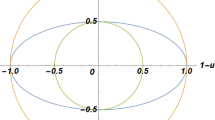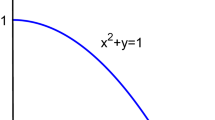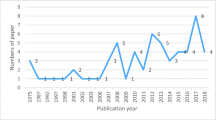Abstract
Type-2 fuzzy sets (T2FSs) have the advantage of representing higher-order uncertainty, they have shown excellent performance in system modeling. However, complexity in mathematical expressions and fundamental operations restricts their application in multi-criteria decision-making. To address this issue, a new representation method for T2FSs is first proposed, and the concepts of double, single discrete T2FSs and single continuous T2FSs are introduced, respectively. Further, the fundamental operations, ranking method and decision-making interpretations for double discrete T2FSs are studied, and the axiomatic framework of fuzzy entropy and distance measure for double discrete T2FSs are also defined. Finally, the technique for order preference by similarity to ideal solution method in type-2 fuzzy environment is developed, and the practicability and effectiveness of the proposed definition and decision-making method are illustrated by validity tests and comparative analyses.





Similar content being viewed by others
Explore related subjects
Discover the latest articles, news and stories from top researchers in related subjects.Data Availability
All data are included in the manus-cript.
References
Zadeh, L.A.: Fuzzy sets. Inf. Control 8(3), 338–353 (1965)
Wang, X.Z., Ruan, D., Kerre, E.E.: Mathematics of Fuzziness-Basic Issues. Springer, Berlin (2009)
Zadeh, L.A.: The concept of a linguistic variable and its application to approximate reasoning-I. Inf. Sci. 8(3), 199–249 (1975)
Pan, Y., Li, Q., Liang, H., Lam, H.K.: A novel mixed control approach for fuzzy systems via membership functions online learning policy. IEEE Trans. Fuzzy Syst. (2021). https://doi.org/10.1109/TFUZZ.2021.3130201
Bellman, R.E., Zadeh, L.A.: Decision-making in a fuzzy environment. Manag. Sci. 17(4), 141–164 (1970)
Zimmermann, H.J.: Fuzzy Set Theory and Its Applications. Kluwer Academic Publishers, London (1991)
Qin, J.D., Liu, X.W.: Type-2 Fuzzy Decision-Making Theories, Methodologies and Applications. Springer, Singapore (2019)
Mendel, J.M.: The perceptual computer: an architecture for computing with words. In: Proceedings of the 10th IEEE International Conference on Fuzzy Systems, pp. 35-38 (2001)
Karnik, N.N., Mendel, J.M.: Centroid of a type-2 fuzzy set. Inf. Sci. 132(1), 195–220 (2001)
Wu, D.R., Mendel, J.M.: Aggregation using the linguistic weighted average and interval type-2 fuzzy sets. IEEE Trans. Fuzzy Syst. 15(6), 1145–1161 (2007)
Wu, D.R., Mendel, J.M.: A comparative study of ranking methods, similarity measures and uncertainty measures for interval type-2 fuzzy sets. Inf. Sci. 179(8), 1169–1192 (2009)
Mizumoto, M., Tanaka, K.: Some properties of fuzzy sets of type-2. Inf. Control 31, 312–340 (1976)
Mendel, J.M., John, R.I.B.: Type-2 fuzzy sets made simple. IEEE Trans. Fuzzy Syst. 10(2), 117–127 (2002)
Mendel, J.M., Rajati, M.R., Sussner, P.: On clarifying some definitions and notations used for type-2 fuzzy sets as well as some recommended changes. Inf. Sci. 340–341, 337–345 (2016)
Mo, H., Wang, J., Li, X., Wu, Z.L.: Linguistic dynamic modeling and analysis of psychological health state using interval type-2 fuzzy sets. IEEE/CAA J Autom. 2(4), 366–373 (2015)
Chiclana, F., Zhou, S.M.: Type-reduction of general type-2 fuzzy sets: the type-1 OWA approach. Int. J. Intell. Syst. 28(5), 505–522 (2013)
De Miguel, L., Santos, H., Sesma-Sara, M., Bedregal, B., Jurio, A.: Type-2 fuzzy entropy-sets. IEEE Trans. Fuzzy Syst. 25(4), 993–1005 (2017)
Rickard, J.T., Aisbett, J., Gibbon, G.: Fuzzy subsethood for fuzzy sets of type-2 and generalized type-n. IEEE Trans. Fuzzy Syst. 17(1), 50–60 (2009)
Mo, H., Wang, F.Y., Zhou, M., Li, R.M., Xiao, Z.Q.: Footprint of uncertainty for type-2 fuzzy sets. Inf. Sci. 272, 96–110 (2014)
Pan, Y., Wu, Y.M., Lam, H.K.: Security-based fuzzy control for nonlinear networked control systems with DoS attacks via a resilient event-triggered scheme. IEEE Trans. Fuzzy Syst. (2022). https://doi.org/10.1109/TFUZZ.2022.3148875
John, R., Hagras, H., Castillo, O.: Type-2 Fuzzy Logic and Systems: Dedicated to Professor Jerry Mendel for his Pioneering Contribution. Springer, Berlin (2018)
Melin, P., Martinez, G.E.: Extension of the Fuzzy Sugeno Integral Based on Generalized Type-2 Fuzzy Logic. Springer, Berlin (2020)
Tang, G.L., Chiclana, F., Lin, X.C., Liu, P.D.: Interval type-2 fuzzy multi-attribute decision-making approaches for evaluating the service quality of Chinese commercial banks. Knowl.-Based Syst. 193, 105438 (2020)
Wu, D.R., Zhang, H.T., Huang, J.: A constrained representation theorem for well-shaped interval type-2 fuzzy sets, and the corresponding constrained uncertainty measures. IEEE Trans. Fuzzy Syst. 27(6), 1237–1251 (2019)
Yang, Y.Y., Liu, X.W., Liu, F.: Trapezoidal interval type-2 fuzzy TOPSIS using alpha-cuts. Int. J. Fuzzy Syst. 22(1), 293–309 (2020)
McCulloch, J., Wagner, C.: On the choice of similarity measures for type-2 fuzzy sets. Inf. Sci. 510, 135–154 (2020)
Xu, Z., Qin, J.D., Liu, J., Martínez, L.: Sustainable supplier selection based on AHPSort II in interval type-2 fuzzy environment. Inf. Sci. 483, 273–293 (2019)
Chen, T.Y.: An interval type-2 fuzzy PROMETHEE method using a likelihood-based outranking comparison approach. Inf. Fusion 25, 105–120 (2015)
Ureña, R., Kou, G., Wu, J., Chiclana, F., Herrera-Viedma, E.: Dealing with incomplete information in linguistic group decision making by means of interval type-2 fuzzy sets. Int. J. Intell. Syst. 34(6), 1261–1280 (2019)
Qin, J.D., Liu, X.W., Pedrycz, W.: A multiple attribute interval type-2 fuzzy group decision making and its application to supplier selection with extended LINMAP method. Soft Comput. 21(12), 3207–3226 (2017)
Wu, T., Liu, X.W., Liu, F.: An interval type-2 fuzzy TOPSIS model for large scale group decision making problems with social network information. Inf. Sci. 432, 392–410 (2018)
Qin, J.D., Liu, X.W., Pedrycz, W.: An extended VIKOR method based on prospect theory for multiple attribute decision making under interval type-2 fuzzy environment. Knowl.-Based Syst. 86, 116–130 (2015)
Qin, J.D., Liu, X.W., Pedrycz, W.: An extended TODIM multi-criteria group decision making method for green supplier selection in interval type-2 fuzzy environment. Eur. J. Oper. Res. 258(2), 626–638 (2017)
Türk, S., Deveci, M., Özcan, E., Canıtez, F., John, R.: Interval type-2 fuzzy sets improved by simulated annealing for locating the electric charging stations. Inf. Sci. 547, 641–666 (2021)
Qin, J.D., Xi, Y., Pedrycz, W.: Failure mode and effects analysis (FMEA) for risk assessment based on interval type-2 fuzzy evidential reasoning method. Appl. Soft Comput. 89, 106134 (2020)
Mendel, J.M., John, R.I., Liu, F.L.: Interval type-2 fuzzy logical systems made simple. IEEE Trans. Fuzzy Syst. 14(6), 808–821 (2006)
Lee, L.W., Chen, S.M.: Fuzzy multiple attributes group decision-making based on the extension of TOPSIS method and interval type-2 fuzzy sets. In: Proceedings of the 2008 International Conference on Machine Learning and Cybernetic, pp. 3260-3265 (2008)
Atanassov, K.T.: Intuitionistic fuzzy sets. Fuzzy Sets Syst. 20, 87–96 (1986)
De, S.K., Biswas, R., Roy, A.R.: Some operations on intuitionistic fuzzy sets. Fuzzy Sets Syst. 114, 477–484 (2000)
Yao, J.S., Lin, F.T.: Constructing a fuzzy flow-shop sequencing model based on statistical data. Int. J. Approx. Reason. 29(3), 215–234 (2002)
Chen, S.M., Chen, J.H.: Fuzzy risk analysis based on similarity measures between interval-valued fuzzy numbers and interval-valued fuzzy number arithmetic operators. Expert Syst. Appl. 36(2–3), 6309–6317 (2009)
Chen, T.Y.: Multiple criteria group decision-making with generalized interval-valued fuzzy numbers based on signed distances and incomplete weights. Appl. Math. Model. 36(7), 3029–3052 (2012)
Chen, S.M., Yang, M.W., Lee, L.W., Yang, S.W.: Fuzzy multiple attributes group decision-making based on ranking interval type-2 fuzzy sets. Expert Syst. Appl. 39(5), 5295–5308 (2012)
Chen, S.M., Hong, J.A.: Fuzzy multiple attributes group decision-making based on ranking interval type-2 fuzzy sets and the TOPSIS method. IEEE Trans. Syst. Man Cybern.-Syst. 44(12), 1665–1673 (2014)
Xu, T.T., Zhang, H., Li, B.Q.: Pythagorean fuzzy entropy and its application in multiple-criteria decision-making. Int. J. Fuzzy Syst. 22(5), 1552–1564 (2020)
Xu, T.T., Zhang, H., Li, B.Q.: Fuzzy entropy and hesitancy entropy in probabilistic hesitant fuzzy information and their applications. Soft Comput. (2022). https://doi.org/10.1007/s00500-022-07309-z
Xu, T.T., Zhang, H., Li, B.Q.: Pythagorean fuzzy TOPSIS method based on 2-tuple probability weight. J. Intell. Fuzzy Syst. 40, 9113–9126 (2021)
Xu, T.T., Zhang, H., Li, B.Q.: Axiomatic framework of fuzzy entropy and hesitancy entropy in fuzzy environment. Soft Comput. 25(2), 1219–1238 (2021)
Liu, X.C.: Entropy, distance measure and similarity measure of fuzzy sets and their relations. Fuzzy Sets Syst. 52, 305–318 (1992)
Wang, X., Triantaphyllou, E.: Ranking irregularities when evaluating alternatives by using some ELECTRE methods. Omega 36(1), 45–63 (2008)
Chen, S.M., Lee, L.W.: Fuzzy multiple attributes group decision-making based on the interval type-2 TOPSIS method. Expert Syst. Appl. 37(4), 2790–2798 (2010)
Chen, S.M., Lee, L.W.: Fuzzy multiple attributes group decision-making based on the ranking values and the arithmetic operations of interval type-2 fuzzy sets. Expert Syst. Appl. 37(1), 824–833 (2010)
Li, Z., Zhang, Z., Yu, W.: Consensus reaching with consistency control in group decision making with incomplete hesitant fuzzy linguistic preference relations. Comput. Ind. Eng. 170, 108311 (2022)
Gao, Y., Zhang, Z.: Consensus reaching with non-cooperative behavior management for personalized individual semantics-based social network group decision making. J. Oper. Res. Soc. (2021). https://doi.org/10.1080/01605682.2021.1997654
Acknowledgements
The authors are very grateful to everyone for suggestions, which have been very helpful in improving the paper. This research are supported by the National Natural Science Foundation of China (No.72071151), and the Natural Science Foundation of Hubei Province (No.2020C FB773).
Author information
Authors and Affiliations
Corresponding author
Ethics declarations
Conflict of interest
The authors declare that they have no conflict of interest.
Appendix
Appendix
1.1 Proof of Theorem 2
Proof
Verifying that (1), (3) and (5) in Theorem 2 hold true, the remaining (2), (4) and (6) can be similarly proved. According to Definitions 7 and 8, the following results can be obtained:
(1) \((\tilde{A}_{1}^{c})^{\lambda }=\{\langle x_{i},((\mu _{\tilde{A}_{1}}(x_{i}))^{c})^{\lambda }\rangle |x_{i}\in X, ((\mu _{\tilde{A}_{1}}(x_{i}))^{c})^{\lambda }\)
\(=\{\langle \tau _{j},(1-\mu _{\mu _{\tilde{A}_{1}}(x_{i})}(\tau _{j}))^{\lambda }\rangle |\tau _{j}\in [0,1],\)
\((1-\mu _{\mu _{\tilde{A}_{1}}(x_{i})}(\tau _{j}))^{\lambda }\in [0,1]\}\}\),
\((\lambda \tilde{A}_{1})^{c}\) \(=\{\langle x_{i},(\lambda \mu _{\tilde{A}_{1}}(x_{i}))^{c}\rangle |x_{i}\in X, (\lambda \mu _{\tilde{A}_{1}}(x_{i}))^{c}\)
\(=\{\langle \tau _{j},1-(1-(1-\mu _{\mu _{\tilde{A}_{1}}(x_{i})}(\tau _{j}))^{\lambda })\rangle |\tau _{j}\)
\(\in [0,1],(1-(1-(1-\mu _{\mu _{\tilde{A}_{1}}(x_{i})}(\tau _{j}))^{\lambda }))\)
\(\in [0,1]\}\}\),
and since
\((1-\mu _{\mu _{\tilde{A}_{1}}(x_{i})}(\tau _{j}))^{\lambda }=1 -(1-(1-\mu _{\mu _{\tilde{A}_{1}}(x_{i})}(\tau _{j}))^{\lambda })\),
so \((\tilde{A}_{1}^{c})^{\lambda }=(\lambda \tilde{A}_{1})^{c}\).
(3) \(\tilde{A}_{1}^{c}\cup \tilde{A}_{2}^{c}\)
\(=\{\langle x_{i},(\mu _{\tilde{A}_{1}}(x_{i}))^{c}\cup (\mu _{\tilde{A}_{2}}(x_{i}))^{c}\rangle |x_{i}\in X,\)
\((\mu _{\tilde{A}_{1}}(x_{i}))^{c}\cup (\mu _{\tilde{A}_{2}}(x_{i}))^{c}=\{\langle \tau _{j},\max (1-\)
\(\mu _{\mu _{\tilde{A}_{1}}(x_{i})}(\tau _{j}),1-\mu _{\mu _{\tilde{A}_{2}}(x_{i})}(\tau _{j}))\rangle |\tau _{j}\in [0,1],\)
\(\max (1-\mu _{\mu _{\tilde{A}_{1}}(x_{i})}(\tau _{j}),1-\mu _{\mu _{\tilde{A}_{2}}(x_{i})}(\tau _{j}))\)
\(\in [0,1]\}\}\),
\((\tilde{A}_{1}\cap \tilde{A}_{2})^{c}\)
\(=\{\langle x_{i},(\mu _{\tilde{A}_{1}}(x_{i})\cap \mu _{\tilde{A}_{2}}(x_{i}))^{c}\rangle |x_{i}\in X, (\mu _{\tilde{A}_{1}}(x_{i})\)
\(\cap \mu _{\tilde{A}_{2}}(x_{i}))^{c}=\{\langle \tau _{j},1-\min (\mu _{\mu _{\tilde{A}_{1}}(x_{i})}(\tau _{j}),\)
\(\mu _{\mu _{\tilde{A}_{2}}(x_{i})}(\tau _{j}))\rangle |\tau _{j}\in [0,1], (1-\min (\mu _{\mu _{\tilde{A}_{1}}(x_{i})}(\tau _{j}),\)
\(\mu _{\mu _{\tilde{A}_{2}}(x_{i})}(\tau _{j})))\in [0,1]\}\}\).
Since \(1-\min (\mu _{\mu _{\tilde{A}_{1}}(x_{i})}(\tau _{j}),\mu _{\mu _{\tilde{A}_{2}} (x_{i})}(\tau _{j}))=\max (1-\mu _{\mu _{\tilde{A}_{1}}(x_{i})}(\tau _{j}),1-\mu _{\mu _{\tilde{A}_{2}}(x_{i})}(\tau _{j}))\), hence \(\tilde{A}_{1}^{c}\cup \tilde{A}_{2}^{c}=(\tilde{A}_{1}\cap \tilde{A}_{2})^{c}\).
(5) \(\tilde{A}_{1}^{\lambda }\cup \tilde{A}_{2}^{\lambda }\)
\(~~=\{\langle x_{i},(\mu _{\tilde{A}_{1}}(x_{i}))^{\lambda }\cup (\mu _{\tilde{A}_{2}}(x_{i}))^{\lambda }\rangle |x_{i}\in X,\)
\((\mu _{\tilde{A}_{1}}(x_{i}))^{\lambda }\cup (\mu _{\tilde{A}_{2}}(x_{i}))^{\lambda } =\{\langle \tau _{j},\)
\(\max ((\mu _{\mu _{\tilde{A}_{1}}(x_{i})}(\tau _{j}))^{\lambda },(\mu _{\mu _{\tilde{A}_{2}}(x_{i})}(\tau _{j}))^{\lambda })\rangle |\)
\(\tau _{j}\in [0,1],\max ((\mu _{\mu _{\tilde{A}_{1}}(x_{i})}(\tau _{j}))^{\lambda },(\mu _{\mu _{\tilde{A}_{2}}(x_{i})}(\tau _{j}))^{\lambda })\)
\(\in [0,1]\}\}\),
\((\tilde{A}_{1}\cup \tilde{A}_{2})^{\lambda }\)
\(=\{\langle x_{i},(\mu _{\tilde{A}_{1}}(x_{i})\cup \mu _{\tilde{A}_{2}}(x_{i}))^{\lambda }\rangle |x_{i}\in X,\)
\((\mu _{\tilde{A}_{1}}(x_{i})\cup \mu _{\tilde{A}_{2}}(x_{i}))^{\lambda }=\{\langle \tau _{j},\)
\((\max (\mu _{\mu _{\tilde{A}_{1}}(x_{i})}(\tau _{j}),\mu _{\mu _{\tilde{A}_{2}}(x_{i})}(\tau _{j})))^{\lambda }\rangle |\tau _{j}\in [0,1],\)
\((\max (\mu _{\mu _{\tilde{A}_{1}}(x_{i})}(\tau _{j}),\mu _{\mu _{\tilde{A}_{2}}(x_{i})}(\tau _{j})))^{\lambda }\in [0,1]\}\}\),
and since
\(\max ((\mu _{\mu _{\tilde{A}_{1}}(x_{i})}(\tau _{j}))^{\lambda },(\mu _{\mu _{\tilde{A}_{2}}(x_{i})}(\tau _{j}))^{\lambda })\)
\(=(\max (\mu _{\mu _{\tilde{A}_{1}}(x_{i})}(\tau _{j}),\mu _{\mu _{\tilde{A}_{2}}(x_{i})}(\tau _{j})))^{\lambda }\),
thus, \(\tilde{A}_{1}^{\lambda }\cup \tilde{A}_{2}^{\lambda }=(\tilde{A}_{1}\cup \tilde{A}_{2})^{\lambda }\).
Proof of Theorem 3
Proof
Verifying that (1), (3) and (5) in Theorem 3 are valid, the rest (2), (4) and (6) can be proved in a similar manner. By Definitions 7 and 8, we can obtain
(1) \(\tilde{A}_{1}^{c}\otimes \tilde{A}_{2}^{c}\)
\(=\{\langle x_{i},(\mu _{\tilde{A}_{1}}(x_{i}))^{c}\otimes (\mu _{\tilde{A}_{1}}(x_{i}))^{c}\rangle |x_{i}\in X,\)
\((\mu _{\tilde{A}_{1}}(x_{i}))^{c}\otimes (\mu _{\tilde{A}_{1}}(x_{i}))^{c}=\{\langle \tau _{j},(1-\)
\(\mu _{\mu _{\tilde{A}_{1}}(x_{i})}(\tau _{j}))(1-\mu _{\mu _{\tilde{A}_{2}}(x_{i})}(\tau _{j}))\rangle |\tau _{j}\in [0,1],\)
\((1-\mu _{\mu _{\tilde{A}_{1}}(x_{i})}(\tau _{j}))(1-\mu _{\mu _{\tilde{A}_{2}}(x_{i})}(\tau _{j}))\in [0,1]\}\}\),
\((\tilde{A}_{1}\oplus \tilde{A}_{2})^{c}\)
\(=\{\langle x_{i},(\mu _{\tilde{A}_{1}}(x_{i})\oplus \mu _{\tilde{A}_{2}}(x_{i}))^{c}\rangle |x_{i}\in X,\)
\((\mu _{\tilde{A}_{1}}(x_{i})\oplus \mu _{\tilde{A}_{2}}(x_{i}))^{c}=\{\langle \tau _{j},1-\mu _{\mu _{\tilde{A}_{1}}(x_{i})}(\tau _{j})\)
\(-\mu _{\mu _{\tilde{A}_{2}}(x_{i})}(\tau _{j})+\mu _{\mu _{\tilde{A}_{1}}(x_{i})}(\tau _{j})\mu _{\mu _{\tilde{A}_{2}}(x_{i})}(\tau _{j})\rangle |\tau _{j}\)
\(\in [0,1],(1-\mu _{\mu _{\tilde{A}_{1}}(x_{i})}(\tau _{j})-\mu _{\mu _{\tilde{A}_{2}}(x_{i})}(\tau _{j})+\)
\(\mu _{\mu _{\tilde{A}_{1}}(x_{i})}(\tau _{j})\mu _{\mu _{\tilde{A}_{2}}(x_{i})}(\tau _{j}))\in [0,1]\}\}\).
Because \((1-\mu _{\mu _{\tilde{A}_{1}}(x_{i})}(\tau _{j}))(1-\mu _{\mu _{\tilde{A}_{2}}(x_{i})}(\tau _{j}))= 1-\mu _{\mu _{\tilde{A}_{1}}(x_{i})}(\tau _{j})-\mu _{\mu _{\tilde{A}_{2}}(x_{i})}(\tau _{j})+ \mu _{\mu _{\tilde{A}_{1}}(x_{i})}(\tau _{j})\mu _{\mu _{\tilde{A}_{2}}(x_{i})}(\tau _{j})\),
\(\tilde{A}_{1}^{c}\otimes \tilde{A}_{2}^{c}=(\tilde{A}_{1}\oplus \tilde{A}_{2})^{c}\).
(3) \(\tilde{A}_{1}^{\lambda }\otimes \tilde{A}_{2}^{\lambda }\)
\(=\{\langle x_{i},(\mu _{\tilde{A}_{1}}(x_{i}))^{\lambda }\otimes (\mu _{\tilde{A}_{1}}(x_{i}))^{\lambda }\rangle |x_{i}\in X,\)
\((\mu _{\tilde{A}_{1}}(x_{i}))^{\lambda }\otimes (\mu _{\tilde{A}_{1}}(x_{i}))^{\lambda }=\{\langle \tau _{j},\)
\((\mu _{\mu _{\tilde{A}_{1}}(x_{i})}(\tau _{j}))^{\lambda }(\mu _{\mu _{\tilde{A}_{2}}(x_{i})}(\tau _{j}))^{\lambda }\rangle |\tau _{j}\in [0,1],\)
\((\mu _{\mu _{\tilde{A}_{1}}(x_{i})}(\tau _{j}))^{\lambda }(\mu _{\mu _{\tilde{A}_{2}}(x_{i})}(\tau _{j}))^{\lambda }\in [0,1]\}\}\),
\((\tilde{A}_{1}\otimes \tilde{A}_{2})^{\lambda }\)
\(=\{\langle x_{i},(\mu _{\tilde{A}_{1}}(x_{i})\otimes \mu _{\tilde{A}_{2}}(x_{i}))^{\lambda }\rangle |x_{i}\in X,\)
\((\mu _{\tilde{A}_{1}}(x_{i})\otimes \mu _{\tilde{A}_{2}}(x_{i}))^{\lambda }=\{\langle \tau _{j},\)
\((\mu _{\mu _{\tilde{A}_{1}}(x_{i})}(\tau _{j})\mu _{\mu _{\tilde{A}_{2}}(x_{i})}(\tau _{j}))^{\lambda }\rangle |\tau _{j}\in [0,1],\)
\((\mu _{\mu _{\tilde{A}_{1}}(x_{i})}(\tau _{j})\mu _{\mu _{\tilde{A}_{2}}(x_{i})}(\tau _{j}))^{\lambda }\in [0,1]\}\}\).
Here, \((\mu _{\mu _{\tilde{A}_{1}}(x_{i})}(\tau _{j}))^{\lambda }(\mu _{\mu _{\tilde{A}_{2}}(x_{i})}(\tau _{j}))^{\lambda }= (\mu _{\mu _{\tilde{A}_{1}}(x_{i})}(\tau _{j})\)
\(\mu _{\mu _{\tilde{A}_{2}}(x_{i})}(\tau _{j}))^{\lambda }\), so \(\tilde{A}_{1}^{\lambda }\otimes \tilde{A}_{2}^{\lambda }=(\tilde{A}_{1}\otimes \tilde{A}_{2})^{\lambda }\).
(5) \(\lambda \tilde{A}_{1}\oplus \lambda \tilde{A}_{2}\)
\(=\{\langle x_{i},\lambda \mu _{\tilde{A}_{1}}(x_{i})\oplus \lambda \mu _{\tilde{A}_{2}}(x_{i})\rangle |x_{i}\in X,\lambda \mu _{\tilde{A}_{1}}(x_{i})\)
\(\oplus \lambda \mu _{\tilde{A}_{2}}(x_{i})=\{\langle \tau _{j}, 1-(1-\mu _{\mu _{\tilde{A}_{1}}(x_{i})}(\tau _{j}))^{\lambda }\)
\((1-\mu _{\mu _{\tilde{A}_{2}}(x_{i})}(\tau _{j}))^{\lambda }\rangle |\tau _{j} \in [0,1],(1-(1-\)
\(\mu _{\mu _{\tilde{A}_{1}}(x_{i})}(\tau _{j}))^{\lambda } (1-\mu _{\mu _{\tilde{A}_{2}}(x_{i})}(\tau _{j}))^{\lambda })\in [0,1]\}\}\),
\(\lambda (\tilde{A}_{1}\oplus \tilde{A}_{2})\)
\(=\{\langle x_{i},\lambda (\mu _{\tilde{A}_{1}}(x_{i})\oplus \mu _{\tilde{A}_{2}}(x_{i}))\rangle |x_{i} \in X,\lambda (\mu _{\tilde{A}_{1}}(x_{i})\)
\(\oplus \mu _{\tilde{A}_{2}}(x_{i}))=\{\langle \tau _{j},1-(1-\mu _{\mu _{\tilde{A}_{1}}(x_{i})}(\tau _{j})-\)
\(\mu _{\mu _{\tilde{A}_{2}}(x_{i})}(\tau _{j})+\mu _{\mu _{\tilde{A}_{1}}(x_{i})}(\tau _{j}) \mu _{\mu _{\tilde{A}_{2}}(x_{i})}(\tau _{j}))^{\lambda }\rangle\)
\(|\tau _{j}\in [0,1],(1-(1-\mu _{\mu _{\tilde{A}_{1}}(x_{i})}(\tau _{j})-\mu _{\mu _{\tilde{A}_{2}}(x_{i})}(\tau _{j})\)
\(+\mu _{\mu _{\tilde{A}_{1}}(x_{i})}(\tau _{j})\mu _{\mu _{\tilde{A}_{2}}(x_{i})}(\tau _{j}))^{\lambda })\in [0,1]\}\}\),
since \(1-(1-\mu _{\mu _{\tilde{A}_{1}}(x_{i})}(\tau _{j}))^{\lambda }(1-\mu _{\mu _{\tilde{A}_{2}}(x_{i})}(\tau _{j}))^{\lambda }= 1-(1-\mu _{\mu _{\tilde{A}_{1}}(x_{i})}(\tau _{j})-\mu _{\mu _{\tilde{A}_{2}}(x_{i})}(\tau _{j}) +\mu _{\mu _{\tilde{A}_{1}}(x_{i})}(\tau _{j}) \mu _{\mu _{\tilde{A}_{2}}(x_{i})}(\tau _{j}))^{\lambda }\), so \(\lambda \tilde{A}_{1}\oplus \lambda \tilde{A}_{2}=\lambda (\tilde{A}_{1}\oplus \tilde{A}_{2})\).
Proof of Theorem 4
Proof
It is proved that (6), (8) and (10) in Theorem 4 hold, the rest (1)-(5), (7) and (9) can be proved similarly. Through Definitions 7 and 8, we can get
(6) \((\tilde{A}_{1}\cup \tilde{A}_{2})\otimes (\tilde{A}_{1}\cap \tilde{A}_{2})\)
\(=\{\langle x_{i},(\mu _{\tilde{A}_{1}}(x_{i})\cup \mu _{\tilde{A}_{2}}(x_{i}))\otimes (\mu _{\tilde{A}_{1}}(x_{i})\cap \mu _{\tilde{A}_{2}}(x_{i}))\rangle\)
\(|x_{i}\in X, (\mu _{\tilde{A}_{1}}(x_{i})\cup \mu _{\tilde{A}_{2}}(x_{i}))\otimes (\mu _{\tilde{A}_{1}}(x_{i})\cap\)
\(\mu _{\tilde{A}_{2}}(x_{i}))=\{\langle \tau _{j},\max (\mu _{\mu _{\tilde{A}_{1}}(x_{i})}(\tau _{j}),\mu _{\mu _{\tilde{A}_{2}}(x_{i})}(\tau _{j}))\)
\(\min (\mu _{\mu _{\tilde{A}_{1}}(x_{i})}(\tau _{j}),\mu _{\mu _{\tilde{A}_{2}}(x_{i})}(\tau _{j}))\rangle |\tau _{j}\in [0,1],\)
\(\max (\mu _{\mu _{\tilde{A}_{1}}(x_{i})}(\tau _{j}),\mu _{\mu _{\tilde{A}_{2}}(x_{i})}(\tau _{j}))\)
\(\min (\mu _{\mu _{\tilde{A}_{1}}(x_{i})}(\tau _{j}),\mu _{\mu _{\tilde{A}_{2}}(x_{i})}(\tau _{j}))\in [0,1]\}\}\),
and since
\(\max (\mu _{\mu _{\tilde{A}_{1}}(x_{i})}(\tau _{j}),\mu _{\mu _{\tilde{A}_{2}}(x_{i})}(\tau _{j})) \min (\mu _{\mu _{\tilde{A}_{1}}(x_{i})}(\tau _{j}),\)
\(\mu _{\mu _{\tilde{A}_{2}}(x_{i})}(\tau _{j}))=\mu _{\mu _{\tilde{A}_{1}}(x_{i})}(\tau _{j}) \mu _{\mu _{\tilde{A}_{2}}(x_{i})}(\tau _{j})\),
so \((\tilde{A}_{1}\cup \tilde{A}_{2})\otimes (\tilde{A}_{1}\cap \tilde{A}_{2})=\tilde{A}_{1}\otimes \tilde{A}_{2}\).
(8) \((\tilde{A}_{1}\cap \tilde{A}_{2})\oplus \tilde{A}_{3}\)
\(=\{\langle x_{i},(\mu _{\tilde{A}_{1}}(x_{i})\cap \mu _{\tilde{A}_{2}}(x_{i}))\oplus \mu _{\tilde{A}_{3}}(x_{i})\rangle |x_{i}\in X,\)
\((\mu _{\tilde{A}_{1}}(x_{i})\cap \mu _{\tilde{A}_{2}}(x_{i}))\oplus \mu _{\tilde{A}_{3}}(x_{i})=\{\langle \tau _{j},\tilde{\mu }\rangle |\tau _{j}\)
\(\in [0,1],\tilde{\mu }\in [0,1]\}\}\),
where \(\tilde{\mu }=\min (\mu _{\mu _{\tilde{A}_{1}}(x_{i})}(\tau _{j}),\mu _{\mu _{\tilde{A}_{2}}(x_{i})} (\tau _{j}))+\mu _{\mu _{\tilde{A}_{3}}(x_{i})}(\tau _{j})\)
\(-\min (\mu _{\mu _{\tilde{A}_{1}}(x_{i})}(\tau _{j}), \mu _{\mu _{\tilde{A}_{2}}(x_{i})}(\tau _{j}))\mu _{\mu _{\tilde{A}_{3}}(x_{i})}(\tau _{j})\).
\((\tilde{A}_{1}\oplus \tilde{A}_{3})\cap (\tilde{A}_{2}\oplus \tilde{A}_{3})\)
\(=\{\langle x_{i},(\mu _{\tilde{A}_{1}}(x_{i})\oplus \mu _{\tilde{A}_{3}}(x_{i})) \cap (\mu _{\tilde{A}_{2}}(x_{i})\oplus \mu _{\tilde{A}_{3}}(x_{i}))\rangle\)
\(|x_{i}\in X, (\mu _{\tilde{A}_{1}}(x_{i})\oplus \mu _{\tilde{A}_{3}}(x_{i})) \cap (\mu _{\tilde{A}_{2}}(x_{i})\oplus\)
\(\mu _{\tilde{A}_{3}}(x_{i}))=\{\langle \tau _{j},\breve{\mu } \rangle |\tau _{j}\in [0,1],\breve{\mu }\in [0,1]\}\}\),
where \(\breve{\mu }=\min (\mu _{\mu _{\tilde{A}_{1}}(x_{i})}(\tau _{j})+\mu _{\mu _{\tilde{A}_{3}}(x_{i})}(\tau _{j})- \mu _{\mu _{\tilde{A}_{1}}(x_{i})}(\tau _{j})\)
\(\mu _{\mu _{\tilde{A}_{3}}(x_{i})}(\tau _{j}),\mu _{\mu _{\tilde{A}_{2}}(x_{i})} (\tau _{j})+\mu _{\mu _{\tilde{A}_{3}}(x_{i})}(\tau _{j})- \mu _{\mu _{\tilde{A}_{2}}(x_{i})}(\tau _{j})\) \(\mu _{\mu _{\tilde{A}_{3}}(x_{i})}(\tau _{j}))\).
Since \(\tilde{\mu }=\breve{\mu }\), hence \((\tilde{A}_{1}\cap \tilde{A}_{2})\oplus \tilde{A}_{3}=(\tilde{A}_{1}\oplus \tilde{A}_{3})\cap (\tilde{A}_{2}\oplus \tilde{A}_{3})\).
(10) \((\tilde{A}_{1}\cap \tilde{A}_{2})\otimes \tilde{A}_{3}\)
\(=\{\langle x_{i},(\mu _{\tilde{A}_{1}}(x_{i})\cap \mu _{\tilde{A}_{2}}(x_{i}))\otimes \mu _{\tilde{A}_{3}}(x_{i})\rangle |x_{i}\in X,\)
\((\mu _{\tilde{A}_{1}}(x_{i})\cap \mu _{\tilde{A}_{2}}(x_{i}))\otimes \mu _{\tilde{A}_{3}}(x_{i})=\{\langle \tau _{j},\)
\(\min (\mu _{\mu _{\tilde{A}_{1}}(x_{i})}(\tau _{j}),\mu _{\mu _{\tilde{A}_{2}}(x_{i})}(\tau _{j}))\mu _{\mu _{\tilde{A}_{3}}(x_{i})}(\tau _{j})\rangle |\tau _{j}\)
\(\in [0,1],\min (\mu _{\mu _{\tilde{A}_{1}}(x_{i})}(\tau _{j}),\mu _{\mu _{\tilde{A}_{2}}(x_{i})}(\tau _{j}))\)
\(\mu _{\mu _{\tilde{A}_{3}}(x_{i})}(\tau _{j})\in [0,1]\}\}\),
\((\tilde{A}_{1}\otimes \tilde{A}_{3})\cap (\tilde{A}_{2}\otimes \tilde{A}_{3})\)
\(=\{\langle x_{i},(\mu _{\tilde{A}_{1}}(x_{i})\otimes \mu _{\tilde{A}_{3}}(x_{i}))\cap (\mu _{\tilde{A}_{2}}(x_{i})\otimes \mu _{\tilde{A}_{3}}(x_{i}))\rangle\)
\(|x_{i}\in X,(\mu _{\tilde{A}_{1}}(x_{i})\otimes \mu _{\tilde{A}_{3}}(x_{i}))\cap (\mu _{\tilde{A}_{2}}(x_{i})\otimes\)
\(\mu _{\tilde{A}_{3}}(x_{i}))=\{\langle \tau _{j},\min (\mu _{\mu _{\tilde{A}_{1}}(x_{i})}(\tau _{j})\mu _{\mu _{\tilde{A}_{3}}(x_{i})}(\tau _{j}),\)
\(\mu _{\mu _{\tilde{A}_{2}}(x_{i})}(\tau _{j})\mu _{\mu _{\tilde{A}_{3}}(x_{i})}(\tau _{j}))\rangle |\tau _{j}\in [0,1],\)
\(\min (\mu _{\mu _{\tilde{A}_{1}}(x_{i})}(\tau _{j})\mu _{\mu _{\tilde{A}_{3}}(x_{i})}(\tau _{j}),\)
\(\mu _{\mu _{\tilde{A}_{2}}(x_{i})}(\tau _{j})\mu _{\mu _{\tilde{A}_{3}}(x_{i})}(\tau _{j}))\in [0,1]\}\}\).
Since \(\min (\mu _{\mu _{\tilde{A}_{1}}(x_{i})}(\tau _{j}),\mu _{\mu _{\tilde{A}_{2}}(x_{i})}(\tau _{j}))\mu _{\mu _{\tilde{A}_{3}}(x_{i})}(\tau _{j})= \min (\mu _{\mu _{\tilde{A}_{1}}(x_{i})}(\tau _{j})\mu _{\mu _{\tilde{A}_{3}}(x_{i})}(\tau _{j}), \mu _{\mu _{\tilde{A}_{2}}(x_{i})}(\tau _{j})\mu _{\mu _{\tilde{A}_{3}}(x_{i})}(\tau _{j}))\),
hence \((\tilde{A}_{1}\cap \tilde{A}_{2})\otimes \tilde{A}_{3}=(\tilde{A}_{1}\otimes \tilde{A}_{3})\cap (\tilde{A}_{2}\otimes \tilde{A}_{3})\).
Proof of Theorem 6
Proof
Here, we provide the proof process of (2) and (4), (1) and (3) can be proved in a similar manner.
(2) If \(\tilde{A}_{1}\succeq \tilde{A}_{2}\), then \(S(\tilde{A}_{1})\ge S(\tilde{A}_{2})\), that is
\(\sum \limits ^{|X|}_{i=1}\sum \limits ^{|\mu _{\tilde{A}_{1}}(x_{i})|}_{j=1}\mu _{\mu _{\tilde{A}_{1}}(x_{i})}(\tau _{j})\ge \sum \limits ^{|X|}_{i=1}\sum \limits ^{|\mu _{\tilde{A}_{2}}(x_{i})|}_{j=1}\mu _{\mu _{\tilde{A}_{2}}(x_{i})}(\tau _{j})\),
so there exists
\(\sum \limits ^{|X|}_{i=1}\sum \limits ^{|\mu _{\tilde{A}_{1}}(x_{i})|}_{j=1}(1-(1-\mu _{\mu _{\tilde{A}_{1}}(x_{i})}(\tau _{j}))^{\lambda })\ge\)
\(\sum \limits ^{|X|}_{i=1}\sum \limits ^{|\mu _{\tilde{A}_{2}}(x_{i})|}_{j=1}(1-(1-\mu _{\mu _{\tilde{A}_{2}}(x_{i})}(\tau _{j}))^{\lambda })\),
i.e., \(\lambda \tilde{A}_{1}\succeq \lambda \tilde{A}_{2}\).
(4) If \(\tilde{A}_{1}\succeq \tilde{A}_{2}\), then \(S(\tilde{A}_{1})\ge S(\tilde{A}_{2})\), i.e.,
\(\sum \limits ^{|X|}_{i=1}\sum \limits ^{|\mu _{\tilde{A}_{1}}(x_{i})|}_{j=1}\mu _{\mu _{\tilde{A}_{1}}(x_{i})}(\tau _{j})\ge \sum \limits ^{|X|}_{i=1}\sum \limits ^{|\mu _{\tilde{A}_{2}}(x_{i})|}_{j=1}\mu _{\mu _{\tilde{A}_{2}}(x_{i})}(\tau _{j})\),
hence we can obtain
\(\sum \limits ^{|X|}_{i=1}\sum \limits ^{|\mu _{\tilde{A}_{1}}(x_{i})|}_{j=1}(\mu _{\mu _{\tilde{A}_{1}}(x_{i})}(\tau _{j})(1- \mu _{\mu _{\tilde{A}_{3}}(x_{i})}(\tau _{j}))+\)
\(\mu _{\mu _{\tilde{A}_{3}}(x_{i})}(\tau _{j}))\ge \sum \limits ^{|X|}_{i=1}\sum \limits ^{|\mu _{\tilde{A}_{2}}(x_{i})|}_{j=1}(\mu _{\mu _{\tilde{A}_{2}}(x_{i})}(\tau _{j})(1-\)
\(\mu _{\mu _{\tilde{A}_{3}}(x_{i})}(\tau _{j}))+\mu _{\mu _{\tilde{A}_{3}}(x_{i})}(\tau _{j}))\),
that is, \(\tilde{A}_{1}\oplus \tilde{A}_{3}\succeq \tilde{A}_{2}\oplus \tilde{A}_{3}\).
Proof of Theorem 7
Proof
Verifying that \(E(\tilde{A})=F(f(\tilde{A}(x_{1})),f(\tilde{A}(x_{2})),..., f(\tilde{A}(x_{n})))\) satisfies axioms (E1)-(E4) in Definition 11. For any \(\tilde{A}, \tilde{A}_{1},\tilde{A}_{2}\in T2FS(X)\), we can obtain
(E1) Since \(\mu _{\mu _{\tilde{A}}(x_{i})}(\tau _{j})\in [0,1]\), \(E(\tilde{A})=F(f(\tilde{A}(x_{1})), f(\tilde{A}(x_{2})),\ldots ,f(\tilde{A}(x_{n})))=0\Leftrightarrow f(\tilde{A}(x_{i}))=g(a_{i1},a_{i2}, \ldots ,a_{i|\tilde{A}(x_{i})|})=0\Leftrightarrow a_{ij}=|\mu _{\mu _{\tilde{A}}(x_{i})}(\tau _{j})-0.5|=0.5\), so \(\mu _{\mu _{\tilde{A}}(x_{i})}(\tau _{j})=0\) or \(\mu _{\mu _{\tilde{A}}(x_{i})}(\tau _{j})=1\).
(E2) Since \(\mu _{\mu _{\tilde{A}}(x_{i})}(\tau _{j})\in [0,1]\), \(E(\tilde{A})=F(f(\tilde{A}(x_{1})), f(\tilde{A}(x_{2})),\ldots ,f(\tilde{A}(x_{n})))=1\Leftrightarrow f(\tilde{A}(x_{i}))=g(a_{i1},a_{i2}, \ldots ,a_{i|\tilde{A}(x_{i})|})=1\Leftrightarrow a_{ij}=|\mu _{\mu _{\tilde{A}}(x_{i})}(\tau _{j})-0.5|=0\), hence \(\mu _{\mu _{\tilde{A}}(x_{i})}(\tau _{j})=0.5\).
(E3) Since \(\tilde{A}_{1}^{c}=\{\langle x_{i},(\mu _{\tilde{A}_{1}}(x_{i}))^{c}\rangle |x_{i}\in X,(\mu _{\tilde{A}_{1}}(x_{i}))^{c} =\{\langle \tau _{j},1-\mu _{\mu _{\tilde{A}_{1}}(x_{i})}(\tau _{j})\rangle |\tau _{j}\in [0,1],(1-\mu _{\mu _{\tilde{A}_{1}}(x_{i})}(\tau _{j}))\in [0,1]\}\}\), and \(a_{ij}=|1-\mu _{\mu _{\tilde{A}_{1}}(x_{i})}(\tau _{j})-0.5|=|0.5-\mu _{\mu _{\tilde{A}_{1}}(x_{i})}(\tau _{j})|\), thus, \(E(\tilde{A}_{1})=E(\tilde{A}_{1}^{c})\).
(E4) Because \(g(a_{i1},a_{i2},\ldots ,a_{i|\tilde{A}(x_{i})|})\) is strictly monotonically decreasing with respect to each \(a_{ij}(j=1,2,\ldots ,|\tilde{A}(x_{i})|)\), \(F(f(\tilde{A}(x_{1})),f(\tilde{A}(x_{2})),\ldots ,f(\tilde{A}(x_{n})))\) is strictly monotonically increasing with respect to each \(f(\tilde{A}(x_{i}))(i=1,2,\ldots ,n)\), when \(|\mu _{\mu _{\tilde{A}_{1}}(x_{i})}(\tau _{j})-0.5|\ge |\mu _{\mu _{\tilde{A}_{2}}(x_{i})}(\tau _{j})-0.5|\), then we can obtain \(f(\tilde{A}_{1}(x_{i}))\le f(\tilde{A}_{2}(x_{i}))\), and \(F(f(\tilde{A}_{1}(x_{1}),f(\tilde{A}_{1}(x_{2})),\ldots ,f(\tilde{A}_{1}(x_{n}))) \le F(f(\tilde{A}_{2}(x_{1})),f(\tilde{A}_{2}(x_{2})),\ldots ,f(\tilde{A}_{2}(x_{n})))\). Therefore, \(E(\tilde{A}_{1})\le E(\tilde{A}_{2})\).
Rights and permissions
Springer Nature or its licensor (e.g. a society or other partner) holds exclusive rights to this article under a publishing agreement with the author(s) or other rightsholder(s); author self-archiving of the accepted manuscript version of this article is solely governed by the terms of such publishing agreement and applicable law.
About this article
Cite this article
Xu, TT., Qin, JD. A New Representation Method for Type-2 Fuzzy Sets and Its Application to Multiple Criteria Decision Making. Int. J. Fuzzy Syst. 25, 1171–1190 (2023). https://doi.org/10.1007/s40815-022-01432-7
Received:
Revised:
Accepted:
Published:
Issue Date:
DOI: https://doi.org/10.1007/s40815-022-01432-7




